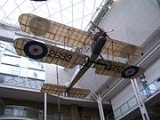
United Kingdom military aircraft serials
Encyclopedia
In the United Kingdom
to identify individual aircraft, all military aircraft are allocated and display a unique serial number
. A unified serial number system, maintained by the Air Ministry
(AM), and its successor the Ministry of Defence
(MoD), is used for aircraft operated by the Royal Air Force
(RAF), Fleet Air Arm
(FAA) and Army Air Corps (AAC). Military aircraft operated by government agencies and civilian contractors (for example QinetiQ
) are also assigned serials from this system.
When the Royal Flying Corps
(RFC) was formed in 1912 aircraft were identified by a letter/number system related to the manufacturer. The prefix "A" was allocated to balloons of No.1 Company, Air Battalion
, Royal Engineers
, the prefix "B" to aeroplanes of No.2 Company, and the prefix "F" to aeroplanes of the Central Flying School
. The Naval Wing used the prefix "H" for seaplanes ("Hydroaeroplanes" as they were then known), "M" for monoplanes, and "T" for aeroplanes with engines mounted in tractor configuration
. Before the end of the first year a unified serial number system was introduced for both Army and Naval aircraft.
The serials are allocated when the contract is placed with the manufacturer or supplier.
In an RAF or FAA pilot's personal, service log book
, the serial number of any aircraft flown, along with any other particulars, such as aircraft type, flight time, purpose of flight, etc., is entered by the pilot after every flight, thus giving a complete record of the pilot's flying activities and which individual aircraft have been flown.
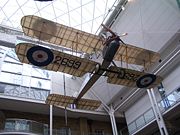 This first series ran from 1 to 10000 with blocks allocated to each service. The first serial was allocated to a Short S.34 for the Royal Naval Air Service
This first series ran from 1 to 10000 with blocks allocated to each service. The first serial was allocated to a Short S.34 for the Royal Naval Air Service
(RNAS), with the number 10000 going to a Blackburn-built B.E.2c aircraft in 1916.
, built by Blackburn Aircraft
) and it was decided to start an alpha-numeric system from A1 (allocated to a Royal Aircraft Factory BE.2d) to A9999 then starting again at B1. The letters A, B, C, D, E, F, H, and J were allocated to the Royal Flying Corps and N1 to N9999 and S1 to S9999 to the Royal Naval Air Service. When the sequence reached the prefix K it was decided to start at K1000 for all subsequent letters instead of K1.
Although the N and S series had earlier been used by RNAS aircraft, the sequence N1000 to N9999 was again used by the Air Ministry for both RAF and RN aircraft. The 'Naval' S sequence had reached only S1865, a Fairey IIIF, but when R9999 was reached in 1939, the next serial allocations did not run on from that point, but instead commenced at T1000.
From 1937 not all aircraft serials were allocated, in order to hide the true number of aircraft in production and service. Gaps in the serial number sequence were sometimes referred to as "blackout blocks". The first example of this practice was an early 1937 order for 200 Avro Manchester
bombers which were allotted the serials L7276-7325, L7373-7402, L7415-7434, L7453-7497, L7515-7549 and L7565-7584, covering a range of 309 possible serial numbers, and thus possibly leading an enemy to over-estimate British military aircraft strength.

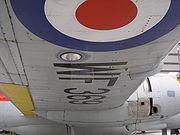 By 1940 the serial Z9978 had been allocated to a Bristol Blenheim
By 1940 the serial Z9978 had been allocated to a Bristol Blenheim
and it was decided to restart the sequence with a two-letter prefix, starting at AA100. This sequence is still in use today. Until the 1990s this 2-letter, 3-numeral serial number sequence, had numbers in the range 100 to 999. An exception to this rule was Douglas Skyraider AEW1 which received the UK serial WT097, which incorporated the last 3 digits of its US Navy Bureau Number 124097. Recently, past unassigned serials, including those having numerals 001-099, have been assigned.
Some letters have not been used to avoid confusion: C confusion with G, I confusion with 1, O and Q confusion with 0, U confusion with V and Y confusion with X.
During the Second World War RAF aircraft carrying secret equipment or that were in themselves secret had "/G" suffix added to the end of the serial, http://www.airliners.net/photo/UK---Navy/De-Havilland-Sea/1312997/L/&width=1200&height=812&sok=WHERE__(reg_%3D_%27LZ551%27)_&sort=_order_by_photo_id_DESC_&photo_nr=1&prev_id=&next_id=1188987 the "G" signifying "Guard", denoting that the aircraft was to have an armed guard at all times while on the ground (for example LZ548/G, the prototype de Havilland Vampire
jet fighter, or ML926/G, a de Havilland Mosquito
XVI experimentally fitted with H2S radar
).
As of 2009, serial allocations have reached the ZKnnn range. However, in recent years, serials have increasingly been allocated out-of-sequence. For example the first RAF C-17 Globemaster
was given the serial ZZ171 in 2001, and a batch of Britten-Norman Defender
s for the AAC were given serials in the ZGnnn range in 2003 (the last ZG serial being allocated more than 14 years previously). Also, some recent serials allocations have had a numeric part in the previously-unused 001 to 099 range.
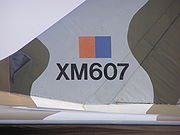
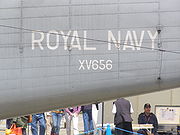 The serial numbers are normally carried in up to four places on each aircraft, on either side of the aircraft on a vertical surface and on the underside of each wing. The underwing serials have not been displayed since the 1960s. The serial on each side is usually on the rear fuselage, but this can vary depending on the aircraft type, for instance the delta winged Gloster Javelin
The serial numbers are normally carried in up to four places on each aircraft, on either side of the aircraft on a vertical surface and on the underside of each wing. The underwing serials have not been displayed since the 1960s. The serial on each side is usually on the rear fuselage, but this can vary depending on the aircraft type, for instance the delta winged Gloster Javelin
had the serial on the forward engine nacelle, and the Avro Vulcan
had the serial on the fin
. Helicopters have only carried serials on each side, either on the tailboom or rear fuselage.
United Kingdom
The United Kingdom of Great Britain and Northern IrelandIn the United Kingdom and Dependencies, other languages have been officially recognised as legitimate autochthonous languages under the European Charter for Regional or Minority Languages...
to identify individual aircraft, all military aircraft are allocated and display a unique serial number
Serial number
A serial number is a unique number assigned for identification which varies from its successor or predecessor by a fixed discrete integer value...
. A unified serial number system, maintained by the Air Ministry
Air Ministry
The Air Ministry was a department of the British Government with the responsibility of managing the affairs of the Royal Air Force, that existed from 1918 to 1964...
(AM), and its successor the Ministry of Defence
Ministry of Defence (United Kingdom)
The Ministry of Defence is the United Kingdom government department responsible for implementation of government defence policy and is the headquarters of the British Armed Forces....
(MoD), is used for aircraft operated by the Royal Air Force
Royal Air Force
The Royal Air Force is the aerial warfare service branch of the British Armed Forces. Formed on 1 April 1918, it is the oldest independent air force in the world...
(RAF), Fleet Air Arm
Fleet Air Arm
The Fleet Air Arm is the branch of the British Royal Navy responsible for the operation of naval aircraft. The Fleet Air Arm currently operates the AgustaWestland Merlin, Westland Sea King and Westland Lynx helicopters...
(FAA) and Army Air Corps (AAC). Military aircraft operated by government agencies and civilian contractors (for example QinetiQ
QinetiQ
Qinetiq is a British global defence technology company, formed from the greater part of the former UK government agency, Defence Evaluation and Research Agency , when it was split up in June 2001...
) are also assigned serials from this system.
When the Royal Flying Corps
Royal Flying Corps
The Royal Flying Corps was the over-land air arm of the British military during most of the First World War. During the early part of the war, the RFC's responsibilities were centred on support of the British Army, via artillery co-operation and photographic reconnaissance...
(RFC) was formed in 1912 aircraft were identified by a letter/number system related to the manufacturer. The prefix "A" was allocated to balloons of No.1 Company, Air Battalion
Air Battalion Royal Engineers
The Air Battalion Royal Engineers was the first flying unit of the British Armed Forces to make use of heavier-than-air craft. It evolved into the Royal Flying Corps which in turn evolved into the Royal Air Force.-Establishment:...
, Royal Engineers
Royal Engineers
The Corps of Royal Engineers, usually just called the Royal Engineers , and commonly known as the Sappers, is one of the corps of the British Army....
, the prefix "B" to aeroplanes of No.2 Company, and the prefix "F" to aeroplanes of the Central Flying School
Central Flying School
The Central Flying School is the Royal Air Force's primary institution for the training of military flying instructors. Established in 1912 it is the longest existing flying training school.-History:...
. The Naval Wing used the prefix "H" for seaplanes ("Hydroaeroplanes" as they were then known), "M" for monoplanes, and "T" for aeroplanes with engines mounted in tractor configuration
Tractor configuration
thumb|right|[[Evektor-Aerotechnik|Aerotechnik EV97A Eurostar]], a tractor configuration aircraft, being pulled into position by its pilot for refuelling....
. Before the end of the first year a unified serial number system was introduced for both Army and Naval aircraft.
The serials are allocated when the contract is placed with the manufacturer or supplier.
In an RAF or FAA pilot's personal, service log book
Logbook
A logbook was originally a book for recording readings from the chip log, and is used to determine the distance a ship traveled within a certain amount of time...
, the serial number of any aircraft flown, along with any other particulars, such as aircraft type, flight time, purpose of flight, etc., is entered by the pilot after every flight, thus giving a complete record of the pilot's flying activities and which individual aircraft have been flown.
1 to 10000

Royal Naval Air Service
The Royal Naval Air Service or RNAS was the air arm of the Royal Navy until near the end of the First World War, when it merged with the British Army's Royal Flying Corps to form a new service , the Royal Air Force...
(RNAS), with the number 10000 going to a Blackburn-built B.E.2c aircraft in 1916.
A1 to Z9999
By 1916 the first sequence had reached 10000 (allocated to a Royal Aircraft Factory BE.2Royal Aircraft Factory BE.2
The Royal Aircraft Factory B.E.2 was a British single-engine two-seat biplane which was in service with the Royal Flying Corps from 1912 until the end of World War I. The "Bleriot" in its designation refers to the fact that, like the Bleriot types it was of tractor configuration, with the...
, built by Blackburn Aircraft
Blackburn Aircraft
Blackburn Aircraft Limited was a British aircraft manufacturer that concentrated mainly on naval and maritime aircraft during the first part of the 20th century.-History:...
) and it was decided to start an alpha-numeric system from A1 (allocated to a Royal Aircraft Factory BE.2d) to A9999 then starting again at B1. The letters A, B, C, D, E, F, H, and J were allocated to the Royal Flying Corps and N1 to N9999 and S1 to S9999 to the Royal Naval Air Service. When the sequence reached the prefix K it was decided to start at K1000 for all subsequent letters instead of K1.
Although the N and S series had earlier been used by RNAS aircraft, the sequence N1000 to N9999 was again used by the Air Ministry for both RAF and RN aircraft. The 'Naval' S sequence had reached only S1865, a Fairey IIIF, but when R9999 was reached in 1939, the next serial allocations did not run on from that point, but instead commenced at T1000.
From 1937 not all aircraft serials were allocated, in order to hide the true number of aircraft in production and service. Gaps in the serial number sequence were sometimes referred to as "blackout blocks". The first example of this practice was an early 1937 order for 200 Avro Manchester
Avro Manchester
|-See also:-References:NotesCitationsBibliography* Buttler, Tony. British Secret Projects: Fighters and Bombers 1935–1950. Hickley, UK: Midland Publishing, 2004. ISBN 978-1857801798....
bombers which were allotted the serials L7276-7325, L7373-7402, L7415-7434, L7453-7497, L7515-7549 and L7565-7584, covering a range of 309 possible serial numbers, and thus possibly leading an enemy to over-estimate British military aircraft strength.
AA100 to ZZ999


Bristol Blenheim
The Bristol Blenheim was a British light bomber aircraft designed and built by the Bristol Aeroplane Company that was used extensively in the early days of the Second World War. It was adapted as an interim long-range and night fighter, pending the availability of the Beaufighter...
and it was decided to restart the sequence with a two-letter prefix, starting at AA100. This sequence is still in use today. Until the 1990s this 2-letter, 3-numeral serial number sequence, had numbers in the range 100 to 999. An exception to this rule was Douglas Skyraider AEW1 which received the UK serial WT097, which incorporated the last 3 digits of its US Navy Bureau Number 124097. Recently, past unassigned serials, including those having numerals 001-099, have been assigned.
Some letters have not been used to avoid confusion: C confusion with G, I confusion with 1, O and Q confusion with 0, U confusion with V and Y confusion with X.
During the Second World War RAF aircraft carrying secret equipment or that were in themselves secret had "/G" suffix added to the end of the serial, http://www.airliners.net/photo/UK---Navy/De-Havilland-Sea/1312997/L/&width=1200&height=812&sok=WHERE__(reg_%3D_%27LZ551%27)_&sort=_order_by_photo_id_DESC_&photo_nr=1&prev_id=&next_id=1188987 the "G" signifying "Guard", denoting that the aircraft was to have an armed guard at all times while on the ground (for example LZ548/G, the prototype de Havilland Vampire
De Havilland Vampire
The de Havilland DH.100 Vampire was a British jet-engine fighter commissioned by the Royal Air Force during the Second World War. Following the Gloster Meteor, it was the second jet fighter to enter service with the RAF. Although it arrived too late to see combat during the war, the Vampire served...
jet fighter, or ML926/G, a de Havilland Mosquito
De Havilland Mosquito
The de Havilland DH.98 Mosquito was a British multi-role combat aircraft that served during the Second World War and the postwar era. It was known affectionately as the "Mossie" to its crews and was also nicknamed "The Wooden Wonder"...
XVI experimentally fitted with H2S radar
H2S radar
H2S was the first airborne, ground scanning radar system. It was developed in Britain in World War II for the Royal Air Force and was used in various RAF bomber aircraft from 1943 to the 1990s. It was designed to identify targets on the ground for night and all-weather bombing...
).
As of 2009, serial allocations have reached the ZKnnn range. However, in recent years, serials have increasingly been allocated out-of-sequence. For example the first RAF C-17 Globemaster
C-17 Globemaster III
The Boeing C-17 Globemaster III is a large military transport aircraft. Developed for the United States Air Force from the 1980s to the early 1990s by McDonnell Douglas, the C-17 is used for rapid strategic airlift of troops and cargo to main operating bases or forward operating bases throughout...
was given the serial ZZ171 in 2001, and a batch of Britten-Norman Defender
Britten-Norman Defender
|-External links:*...
s for the AAC were given serials in the ZGnnn range in 2003 (the last ZG serial being allocated more than 14 years previously). Also, some recent serials allocations have had a numeric part in the previously-unused 001 to 099 range.
'Maintenance' serials
Distinct serial numbering systems are used to identify non-flying airframes used for ground training. The RAF have used a numeric sequence with an 'M' suffix sometimes referred to as the 'Maintenance' series. Known allocations, made between 1921 and 2000, ranged from 540M to 9344M, when this sequence was terminated. The main series of single letter serials did not use 'M' to avoid confusion with the suffix 'M'. The Fleet Air Arm use an 'A'-prefixed sequence (e.g. A2606) and the Army Air Corps issue 'TAD' numbers to their instructional airframes (e.g. TAD015).Display


Gloster Javelin
The Gloster Javelin was an "all-weather" interceptor aircraft that served with Britain's Royal Air Force in the late 1950s and most of the 1960s...
had the serial on the forward engine nacelle, and the Avro Vulcan
Avro Vulcan
The Avro Vulcan, sometimes referred to as the Hawker Siddeley Vulcan, was a jet-powered delta wing strategic bomber, operated by the Royal Air Force from 1956 until 1984. Aircraft manufacturer A V Roe & Co designed the Vulcan in response to Specification B.35/46. Of the three V bombers produced,...
had the serial on the fin
Fin
A fin is a surface used for stability and/or to produce lift and thrust or to steer while traveling in water, air, or other fluid media, . The first use of the word was for the limbs of fish, but has been extended to include other animal limbs and man-made devices...
. Helicopters have only carried serials on each side, either on the tailboom or rear fuselage.
See also
- United Kingdom aircraft registrationUnited Kingdom aircraft registrationUnited Kingdom aircraft registration is a register and means of identifcation for British owned and operated commercial and private aircraft, they are identified by registration letters starting with the prefix G-.-Registration:...
- United Kingdom aircraft test serialsUnited Kingdom aircraft test serialsUnited Kingdom aircraft test serials are used to externally identify aircraft flown within the United Kingdom without a full Certificate of Airworthiness...
- British military aircraft designation systemsBritish military aircraft designation systemsBritish military aircraft designations are used to refer to aircraft types and variants operated by the armed forces of the United Kingdom.Since the end of the First World War, aircraft types in British military service have generally been known by a name British military aircraft designations are...
- Royal Air Force roundelsRoyal Air Force roundelsThe Royal Air Force roundel is a circular identification mark painted on aircraft to identify them to other aircraft and ground forces. In one form or another, it has been used on British military aircraft from 1915 to the present....
- List of RAF Squadron Codes
- United States military aircraft serialsUnited States military aircraft serialsIn the United States, all military aircraft display a serial number to identify individual aircraft. Because these numbers are located on the aircraft tail, they are sometimes referred to unofficially as "tail numbers"...

